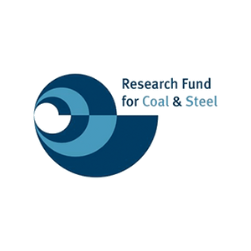HBI C-Flex

About us
Being in line with the EU Green Deal objectives regarding the support of clean steel breakthrough technologies, sustainability and to protect workers along the process chain, HBI C-Flex demonstrates the direct reduction of iron ore using various qualities (including lower-grade ores being typically not used for direct reduction) followed by hot briquetting. Flexible carbon contents will be reached also including zero-carbon products. This generates important knowledge beyond state-of-the-art, establishing the EU steel sector as an international leader for low-carbon materials. Hot briquetted iron (HBI), as well as direct reduced iron (DRI) will be subject of reoxidation trials under changing ambient conditions (dry and wet atmosphere, enhanced temperature) to quantify exothermic reactions during onsite storage, rail and maritime transportation. Mineralogical, mechanical and metallurgical analyses of the DRI/HBI before and after reoxidation will be performed. The International Maritime Solid Bulk Cargoes (IMSBC) Code, representing an important regulation for safe international maritime transport of iron products is another basis of the HBI C-Flex project, apart from RFCS and EU policy initiatives. HBI C-Flex will extend the IMSBC Code to cover zero-carbon HBI and will define strategies for safe handling and onsite storage.
HBI C-Flex will contribute to new, sustainable and low-carbon steelmaking materials, being an important goal of the RFCS programme. The excellent consortium comprises a mix of steel producers, technology providers, RTOs and universities with outstanding know-how in ironmaking. A Supportive Advisory Board led by the International Iron Metallics Association comprises among others ESTEP and worldsteel. Both organisations are aware of the importance of this project and the necessity that the topic of handling zero-carbon HBI must now be investigated to facilitate the EU’s push forward towards a modern, resource-efficient and competitive economy.
Objectives
Since not all steel demand can be covered by recycling scrap, primary steel production must also decarbonise to meet the EU Green Deal objectives. This requirement induces the need to increase the production and use of Direct Reduced Iron (DRI) and Hot Briquetted Iron (HBI). These materials serve as enablers of the steel circular economy by diluting the metallic and other impurities present in lower quality grades of scrap. A large amount of the iron ore available today does not meet the required grade for DRI-based Electric Arc Furnace (EAF) steelmaking. As a result, there is a need for the utilization of this higher share of lower-grade ores. The pathway to decarbonisation of the steel industry envisages DRI/HBI being produced using hydrogen (H2) rather than natural gas with a consequent impact on product properties, notably carbon (C) content. The objectives of the HBI C-Flex project are:
- HBI with flexible carbon contents (down to 0%) will be produced and evaluated in terms of reactivity and stability. This knowledge is important for the EU steelmakers to see how carbon-free HBI can be transported and stored to and within their sites without safety risks.
- Direct reduction will be demonstrated using a huge spectrum of iron ores globally available also comprising low-grade ores being traditionally used in a BF; this induces a more sustainable and circular use of resources.
- The knowledge about reactivity and stability (dust formation) during HBI handling will be valuable for steelmakers in terms of logistics and up-skilling of workers’ awareness of how to avoid hazardous situations during their daily work.


